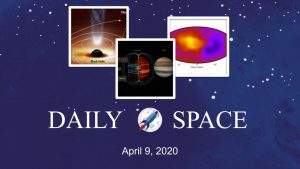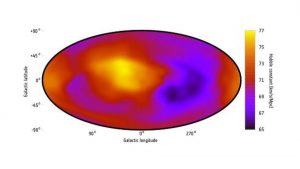
Black holes bend light that can be seen with the help of dust, the universe may not be expanding in a uniform amount across all directions, and astronomers measure wind speed on a brown dwarf for the first time.
Links
Black Hole bends light with help of dust
- Black Hole Bends Light Back on Itself (Caltech)
Expansion of the Universe is not Uniform
- Universe’s Expansion May Not Be The Same In All Directions (Chandra X-Ray Observatory)
- Rethinking cosmology universe expansion may not be uniform (ESA)
Wind speed measured on brown dwarf
- Astronomers Measure Wind Speed on a Brown Dwarf (NRAO)
- Center for Astrophysics Scientist and Team First to Measure Wind Speed on an Object Outside the Solar System (Harvard)
- Allers Develops New Technique to Measure Wind Speed Outside Solar System (Bucknell)
Transcript
This is the Daily Space for today, Friday, April 10, 2020.
Welcome to the Daily Space, I am your host, Dr Pamela Gay, and I am here to put science in your brain. Most Mondays through Fridays either I or my co-host Annie Wilson will be here, bringing you a quick run down of all that is new in space and astronomy.
Do you like relativity? I hope you like relativity, because today I’ve got relativity.
And relativity is awesome and weird.
Here is what you need to know: Light doesn’t have mass, but it has energy and thanks to good ol’ E=mc^2, gravity can affect light. Since light goes, by definition, the speed of light, gravity can’t speed up or slow down light, but it can change its energy – which is visible as a change in color – and gravity can totally change the path of light. This way light bends gravity is effectively identical to what we do with curved mirrors and lenses of different shapes, and chance alignments between nearby massive objects and distant light sources allows us to see magnified images that aren’t just magnified by our telescopes, but are rather also magnified by the intervening gravity.
The thing is, just like fun house mirrors and some crazy and crazy lenses can warp light in really weird ways, gravity can also twist light in the extremes, and when I say extremes, I mean extremes. It was long ago realized that black holes should have the capacity to bend light effectively into orbit around them. Seeing this is nearly impossible however, because if the light is orbiting a black hole, it’s not exactly going to make it into our telescopes and onto our sensors.

A multi-institutional team led by CalTech’s Riley Connors, however, found a way to see this kind of light nevertheless – they just needed the help of some dust.
The stellar mass black hole XTE J1550-564 is actively feeding on a binary star companion, and the mass it pulls off forms a small accretion disk that emits light, and like all regular matter, is also capable of reflecting light. It’s this ability to reflect light that made the impossible possible. In this system, the super hot disk emits light that is bent by the black hole, and that new path can return light that left one side of the disk, back to the disk on the other side of the black hole. Now here is where this work got tricky. These researchers used archival data from the now retired Rossi X-ray Timing Explorer to try and discern which photons were coming directly from the disk, and which photons were reflected off the disk. This sounds like a crazy feat, but X-ray photons are so few in number that X-ray researchers will periodically name their photons… because they can. By looking carefully at the light, they could measure the tiny color differences between directly emitted photons, and reflected photons. Future work using this technique has the potential to be able to even measure the effect that rotation has on how black holes warp the space around them, but for now this new technique is enough to allow them to confirm relativity in one new way.
Where that research left me comfortably thinking we do indeed understand the universe, the next story left me feeling that I need to go back to bed and start over, because nothing makes sense any more.
You are warned.
There are a few simple rules we use when we study our far flung universe. We assume the same physics here are at play everywhere. We assume that at a large enough scale the universe is the same everywhere; that it’s homogeneous. We assume that what we see happening here, at large scales is happening everywhere – essentially that it’s isotropic. Put together, this is our cosmological principle and it is at the heart of everything we do when we model our universe at the largest scales. We haven’t been able to directly measure these assumptions, until, maybe, now.

There are different things in our universe that physics tells us should all give us off the same amount of light. Hot gas, for instance, obeys standard gas laws, and should glow with consistent luminosity when heated to a characteristic temperature by a given mass’ crushing gravity. In theory, if we see systems of similar temperature, we should see them glowing with the same luminosity and appearing equally bright when placed at equal distances.
But apparently we don’t.
PhD Researcher Konstantinos Migkas unexpectedly made this discovery while looking at 800 galaxy clusters across the entire sky. Distances were based on the observed redshifts of the clusters – the observed recessional velocity caused by the expansion of the universe. If the universe has had the same expansion velocity everywhere at any given moment in time, all objects at the same distance will be moving at the same velocity, and standard candles – objects that give off a standard luminosity – will all appear equally bright.
Again though – this isn’t what was seen. What was seen was galaxy clusters at the same temperature and same redshift had different brightnesses. This implies that all else corrected for, these systems aren’t actually at the same distance, and the expansion of the universe isn’t the same everywhere.
In mapping out these variations, they found smooth changes over the sky, and it appears that they can’t explain these results with intervening dust that might be blocking light or with any other natural phenomena.
This variation isn’t small either. This is a variation of 30%. Researchers from multiple institutions did everything they could to figure out what this graduate student had accidently found while doing an all sky, big data analysis of galaxy cluster X-Ray brightnesses. They couldn’t make the result go away. It appears real.
And I’m going to try and get this young researcher on to talk about these results, because I personally want to know what it feels like to accidentally turn our basic understanding of the universe on its head. If this result proves true, everything is about to get a whole lot more difficult to study, and this early career research may be in line for a lot of awards and a more interesting career than they may have expected.
But for now, I’m not going to lie, this result kind of hurts my brain, and we’re now going to switch gears to a much less universe breaking result.

CREDIT: Bill Saxton, NRAO/AUI/NSF
In our final story of the day, we’d like to note that a team of researchers has taken lessons learned from studying Jupiter and Saturn, and applied those lessons to studying a nearby brown dwarf star. Specifically, planetary scientists had realized that if they use radio telescopes to measure the rotation of the core of a planet they saw a different rotation rate than they saw at the surface of the world. The difference in these two rates had to go somewhere, and this case the energy was lost to the wind – literally it was lost to planetary outflows. Thanks to spacecraft at Jupiter and Saturn it was possible to physically measure these winds and check all the relationships. This relationship between inner and outer rotation rates and wind can be expressed in straight-forward equations that should be applicable to all similarly structured objects.
And here is where one day astronomer Katelyn Allers had the realization that brown dwarfs count as similarly structured objects. And she realized no one had published on this application before. Allers and her team used data from the Spitzer Space Telescope and VLA to study the nearby brown dwarf 2MASS J1047+21, which is only 34 light years away. These two sets of data allowed them to measure the dwarf to be rotating once every 1.758 days in the interior, and once every 1.741 hours in the atmosphere. This difference resulted in a wind of 650 m/s. This rate matched predictions on how wind speeds should change as objects gain mass from Saturn, to Jupiter, to these 40 Jupiter mass failed-starts. This is a cool piece of science, and it shows that we really need more interdisciplinary thinking, with astronomers and planetary scientists, as well as geologists, all taking time now and then to learn from one another.
And that rounds out our show for today.
<———————>
As part of helping keep us all occupied in these really weird times, we’re going to be hosting a lot of additional content on our Twitch channel, and we want to remind you that CosmoQuest has an active community on Discord where you can talk science, volunteer for various projects, and even find other people to join you in playing some online games. You can find links to everything that is going on at CosmoQuest.org. Thank you all for listening. Today’s script was written by Pamela Gay, and the Daily Space is produced by Susie Murph. The Daily Space is a product of the Planetary Science Institute, a 501(c)3 non profit dedicated to exploring our Solar System and beyond. We are here thanks to the generous contributions of people like you. The best way you can support us is through Patreon.com/cosmoquestx Like us? Please share us! You never know whose life you can change by adding a daily dose of science.


 We record most shows live, on Twitch. Follow us today to get alerts when we go live.
We record most shows live, on Twitch. Follow us today to get alerts when we go live.